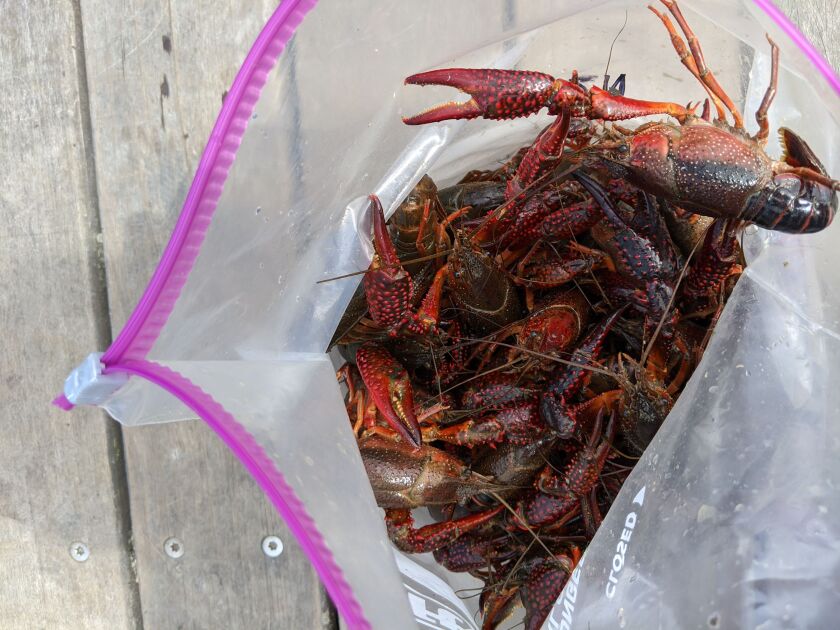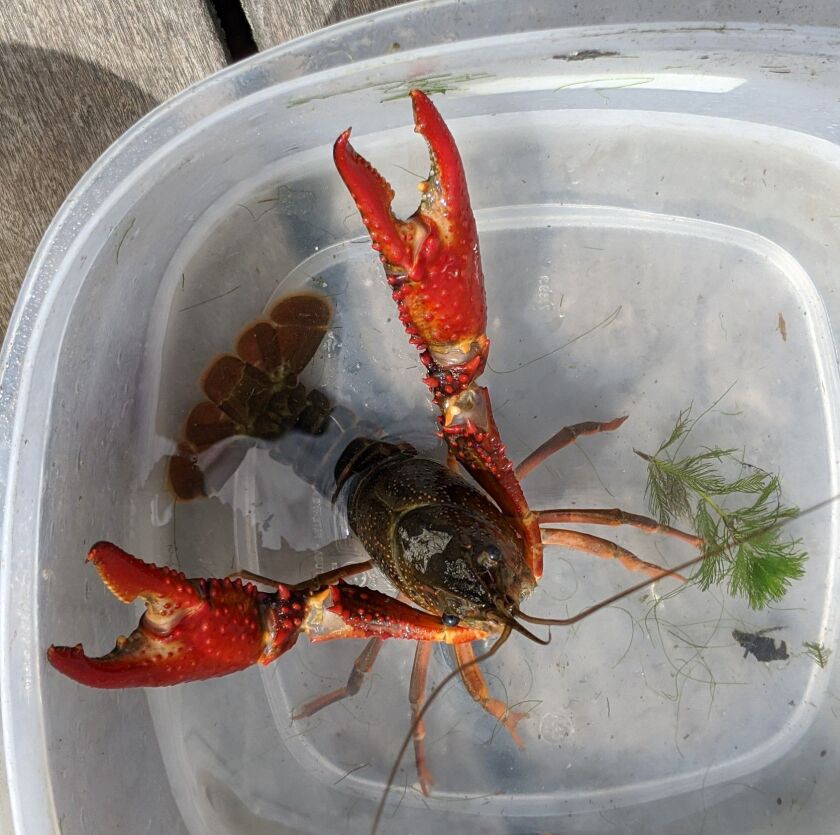After Rachel Egly and Thomas Knapp tied up the Tracker Topper 12W, they set three plastic tubs of invasive crayfish on the dock at River Park.
A male red swamp crayfish vigorously waved its long claws from inside its tub. They also brought back a female red swamp, with smaller claws, and a rusty crayfish.
Egly and Knapp were midway through checking traps last week as part of an ongoing study of invasive crayfish.
Normally they see “a whole lot of invasive red swamp crayfish and rusty crayfish,” Egly said. “Occasionally, we see a few native white river and calico crayfish.”
At a conference last year, I sat next to Reuben Keller, an associate professor at Loyola University. He mentioned trapping invasive crayfish on the Chicago River. Keller founded the Keller Lab, an aquatic invasive ecology research lab at Loyola. Egly is the lab manager.
The pandemic sidelined plans for me to ride along while they checked traps. Even doing the survey for a third year was in question. But, they were cleared to start in July. Normally, they check traps twice a week June through early October.
In 2018 and 19 they did a 100-meter stretch of traps just upstream of the launch at River Park and a 100-meter stretch just downstream. The control section was farther upstream.
Their trapping dropped the populations to one third compared to the control sections, from 1.2 per trap in the control to .4 in the trapping area. By 2019, it was more striking: 1.5 vs .3 or .4.
Experimentation found cheap hot dogs made the most effective bait.
They also learned to set the traps closer together. In a study, Egly used nail polish to mark and number crayfish released and recaptured.
“Rarely were they more than 10 meters away, sometimes they were even [recaught] in the same trap,” Keller said.
So Egly started setting traps only five meters apart.
Red swamp crayfish are centered on the North Shore Channel and the North Branch near River Park. Density lessens closer to the Wilmette connection to Lake Michigan. They have trapped very few farther downstream on the North Branch, Keller speculated that it is either difficulty trapping there or the deep sharp walls are not favorable.
As invasives, red swamp crayfish supplant or push out natives. As a burrowing crayfish, they increase turbidity and even undermine levies.
“They’re voracious omnivores, they’ll eat about anything,” Keller said.
They eat aquatic vegetation, leading to destruction of important nursery habitat for young fish.
But red swamp crayfish have a weakness born of strength.
“Red swamp crayfish are always wanting to fight and they are much more aggressive,” Keller said.
But a fight with a fish is not fair. For crayfish.
Trapping effectively reduces red swamp crayfish. Egly emailed that in 2019 they removed “97 pounds of invasive red swamp crayfish from the North Branch and North Shore Channel in just four months of sampling.” In 2019, they caught 3,400 red swamp crayfish in total. On an average sampling day, they catch about 275 crayfish.
Keller and his team plan to study what fish in the area are effectively eating crayfish. They plan to piggyback with the Illinois Department of Natural Resources and U.S. Fish and Wildlife Service in regular Asian carp surveys to collect some fish. If certain species are more adept at preying on red swamp crayfish, it might make sense to stock them for control.
Since removal of the dam on the North Branch at the confluence with the North Shore Channel, finds of natives increased. In 2018, they found no native crayfish. Now they are finding three or four natives a day.
“That is really cool,” Egly said.
Before the crayfish in the non-control sections are frozen (euthanized) at the lab, data is taken on sex (males are divided into Form 1, sexually active, and Form 2), size and weight.
Red swamp crayfish most likely arrived as released classroom pets. Other possibilities are as discarded fishing bait or leftovers/escapees from crayfish boils.
As Egly and Knapp prepped to finish checking traps, four women paddlers spotted the crayfish, then asked questions. A bright red hand-sized crayfish looking ready to break into Zoidberg’s voice and waving out-sized claws will draw questions.
Egly powered the 5hp Mercury on the Tracker from the dock and headed upstream on the North Shore Channel.
It was a time.
As Keller, his daughter Susannah and I walked off, a father and son, who had waited patiently, came out to shoot a dance video.
TikTok on the Dock.
The Field Museum has a good guide online: “Common crayfishes of the Chicago Region.”
More on Keller Lab is at kellerlabluc.wixsite.com/kellerlab.








